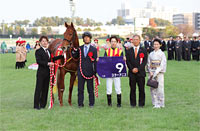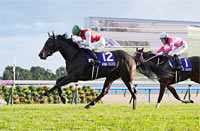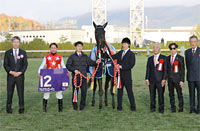Hanshin Juvenile Fillies (G1) - Data Analysis
2-year-old filly champion decider mainly contested by favored runners in recent years
The Hanshin Juvenile Fillies decides the 2-year-old filly champion. In the past, the race was known for upsets and even produced an all-time high payout for a G1 race (120,740 yen for Quinella bet in 1992). Since 2006, however, runners backed as 5th favorite or higher have produced all winners. This year again, the big question is whether one of the fancied runners will triumph, or whether a poorly favored runner will rise to the top for the first time in many years. Let’s now analyze the data for the last 10 years in search of the leading contenders.
Standout performances by runners with 2 career starts
Looking at performances in terms of total career starts, we find that runners with 2 career starts had by far the highest success ratios. This should be the first factor to consider when planning bets. Conversely, runners with 5 or more career starts produced zero Top 3 finishers over the last 10 years. Since this G1 race is geared toward 2-year-olds, a sizeable number of runners entering the race had previously won a newcomer race. However, runners in this group have not delivered a winner since 2011 (Joie de Vivre) or a Top 3 finisher since 2012 (Red Cecilia). In other words, they have underperformed in recent years. [Table 1]
[Table 1] Performance by total career starts (last 10 years)
| Total career starts |
Performance
[1st-2nd-3rd-4th or lower] |
Win ratio |
Top 2 ratio |
Top 3 ratio |
| 1 |
1-0-1-13 |
6.7% |
6.7% |
13.3% |
| 2 |
6-3-5-32 |
13.0% |
19.6% |
30.4% |
| 3 |
3-3-3-52 |
4.9% |
9.8% |
14.8% |
| 4 |
0-4-1-27 |
0% |
12.5% |
15.6% |
| 5 or more |
0-0-0-24 |
0% |
0% |
0% |
Consider runners that were beaten in previous race, but only to 2nd place
A common trend in many graded races for 2-year-olds is that comebacks by runners that have suffered a major defeated in their previous race are extremely rare. In the Hanshin Juvenile Fillies over the last 10 years, runners that had been beaten to 6th or lower in their previous race have produced zero Top 3 finishers. Meanwhile, eight of the 10 winners had finished 1st in their previous race, with the remaining two finishing 2nd in their previous race. Over the last four years, in particular, runners that had finished either 1st or 2nd in their previous race consistently occupied the entire Top 3. If we include runners that have finished 3rd or lower in their previous race in our bets, we should consider only one of these at most. [Table 2]
[Table 2] Performance by finish in the previous race (last 10 years)
| Finish in previous race |
Performance
[1st-2nd-3rd-4th or lower] |
Win ratio |
Top 2 ratio |
Top 3 ratio |
| 1st |
8-7-5-72 |
8.7% |
16.3% |
21.7% |
| 2nd |
2-1-3-16 |
9.1% |
13.6% |
27.3% |
| 3rd |
0-1-1-7 |
0% |
11.1% |
22.2% |
| 4th |
0-0-1-13 |
0% |
0% |
7.1% |
| 5th |
0-1-0-9 |
0% |
10.0% |
10.0% |
| 6th or lower |
0-0-0-31 |
0% |
0% |
0% |
Focus on runners that have contested their previous race at Tokyo Racecourse
Looking at performances in terms of the racecourse of the previous race, we observe that runners that had contested their previous race at Tokyo Racecourse enjoyed high success ratios. This suggests that runners with experience of contesting a race on a track with long homestretch and a rising slope on the straight section tend perform well. Many runners coming from a race contested at Tokyo Racecourse have enjoyed success in the Hanshin Juvenile Fillies despite low favoritism, with examples including 2015 runner-up Win Fabulous (backed as 10th favorite), 2014 winner Shonan Adela (backed as 5th favorite), 2013 third-place finisher Forevermore (backed as 8th favorite), and 2012 third-place finisher Red Cecilia (backed as 10th favorite). [Table 3]
[Table 3] Performance by racecourse of previous race (last 10 years)
Racecourse of
previous race |
Performance
[1st-2nd-3rd-4th or lower] |
Win ratio |
Top 2 ratio |
Top 3 ratio |
| Tokyo |
4-4-8-41 |
7.0% |
14.0% |
28.1% |
| Kyoto |
5-4-1-85 |
5.3% |
9.5% |
10.5% |
| Other racecourse |
1-2-1-22 |
3.8% |
11.5% |
15.4% |
Watch runners that have contested their debut race over a distance of 1,600 meters or more
Runners that targeted major races over a distance of 1,600 meters or more from before their debut race appear to have performed well, and those that had contested their debut race over such a distance achieved high Top 3 ratios. While 2019 winner Resistencia had contested her debut race over a distance of 1,400 meters, this marked the first Top 2 finish by a runner with such a track record since Harp Star finished as runner-up in 2013. This basically suggests that we should keep an eye on runners that have contested their debut race over a distance of 1,600 meters or more. [Table 4]
[Table 4] Performance by distance of debut race (last 10 years)
| Distance |
Performance
[1st-2nd-3rd-4th or lower] |
Win ratio |
Top 2 ratio |
Top 3 ratio |
| 1,300m or lower |
0-3-3-47 |
0% |
5.7% |
11.3% |
| 1,400m |
1-1-1-41 |
2.3% |
4.5% |
6.8% |
| 1,500m |
1-0-0-5 |
16.7% |
16.7% |
16.7% |
| 1,600m |
5-4-5-42 |
8.9% |
16.1% |
25.0% |
| 1,800m |
3-2-1-13 |
15.8% |
26.3% |
31.6% |
Seek out the winner!
Check record in open-class races and “closing speed” in debut race
While runners coming straight from a victory in a newcomer race or 1-win class race have historically produced many winners, the recent five winners had all notched a win in an open-special race or achieved a Top 2 finish in a graded race. In 2019, the Hanshin Juvenile Fillies saw its first win by the front-runner since 2006, when the race was moved to the outer oval turf track of Hanshin Racecourse. However, most wins in the race are secured through a final sprint from the middle or back of the pack. If we compare the last 10 winners’ estimated time over the final three furlongs in a newcomer race to gauge the closing speed, we note that their closing time was around 33 seconds in newcomer races held at Tokyo Racecourse, Hanshin Racecourse, and Niigata Racecourse (each of them has a long homestretch that contributes to a fast closing speed), and 34.0-34.4s for other racecourses. In other words, we should focus on runners that have exhibited a fast closing speed since their debut race. [Table 5]
[Table 5] Winners’ record in major open-class race and estimated time over the final three furlongs in newcomer race (last 10 years)
| Year |
Winner |
Record in open-class race |
Estimated time over the final three furlongs in newcomer race |
| 2010 |
Reve d’Essor |
Daily Hai Nisai Stakes, 1st |
Sapporo, 34.3s (1st) |
| 2011 |
Joie de Vivre |
- |
Kyoto, 34.1s (2nd) |
| 2012 |
Robe Tissage |
KBS Kyoto Sho Fantasy Stakes, 2nd |
Hakodate, 35.8s (1st) |
| 2013 |
Red Reveur |
Sapporo Nisai Stakes, 1st |
Hanshin, 33.3s (1st) |
| 2014 |
Shonan Adela |
- |
Niigata, 33.5s (2nd) |
| 2015 |
Major Emblem |
Artemis Stakes, 2nd |
Tokyo, 33.8s (2nd) |
| 2016 |
Soul Stirring |
Ivy Stakes, 1st |
Sapporo, 34.2s (1st) |
| 2017 |
Lucky Lilac |
Artemis Stakes, 1st |
Niigata, 33.1s (2nd) |
| 2018 |
Danon Fantasy |
KBS Kyoto Sho Fantasy Stakes, 1st |
Tokyo, 33.7s (2nd) |
| 2019 |
Resistencia |
KBS Kyoto Sho Fantasy Stakes, 1st |
Kyoto, 35.8s (6th) |
(Yodohito Himezono)
|

- Preview
- Barrier draw
- News
- Race result
- Video
- 2025 English

- 2024 English

- 2023 English

- 2022 English

- 2021 English

- 2020 English

- 2019 English

- 2018 English

- 2017 English

- 2016 English

- 2015 English

- 2014 English

- 2013 English

- 2012 English

- Photo Gallery
2025 Winner: Star Anise


2024 Winner: Arma Veloce


|


















